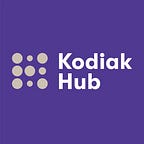Blockchain for Supply Chainge: Do you want to be a supply chain Unicorn?
Blockchain is becoming the Tom Hanks of business technology: always relevant, and able to play a lot of different roles.
Just as Tom Hanks can be Captain Phillips, Forest Gump all while Saving Private Ryan, Blockchain technology can transfer crypto-currency to donation funds, improve inventory management for Walmart, all while linking traceability and transparency back to the burrito I stuff my face with, at Chipotle.
Blockchain Technology has dynamic capabilities, many of which are still yet to be discovered. But that doesn’t mean tech guru’s, and large corporations, aren’t investing big money into figuring out how they can utilize the blockchain.
One area of business that is still testing the waters of blockchain technology is supply chain operations and strategies.
We would like to dedicate this Kodiak Community to blockchain technology, in regards to the supply chain(ge). How can it be utilized? What examples are present today? And, from this, we may even be able to draw some conclusions as to where we see blockchain technology going in the coming years.
But before we start eating the salt at the bottom of the pretzel bag, lets take a deep breath, and begin by building an understanding of blockchain technology.
Blockchain in Layman
The blockchain is typically described as a public ledger or a decentralized database.
I’m going steal/paraphrase this next part of the definition from Ben Siegel of ConsenSys, which I feel kind of bad about because it’s such a damn good definition. Then again, when I heard him present this definition at Katapult Future Festival in Oslo 3, he divulged that he too had stolen the definition from a co-worker at ConsenSys.
Blockchain is like a piece of paper. If I write my name on that piece of paper, and others around me too write their names on that piece of paper, and we all acknowledge that we wrote our names on that piece of paper, then our names stay there. The list of names cannot be erased, or altered from their original state. There can be additions of new names or added information from the original group of individuals that wrote their names, but otherwise, the information remains untouched and that piece of paper can never be destroyed.
Simple right?
The ledger serves as a public, or private (depending how one wants to utilize the blockchain), agreement platform where databases of factual, real-time data can be created and stored without requiring the validation of a centralized source, but rather only the approval of the other nodes (members) of ledger. This ledger’s existence is infinite, and the transactions between nodes (persons or entities) within the chain is visible to all yet can still be kept confidential considering blockchain identities function through unique alphanumeric address/lines of code. “The digital nature of the ledger means that blockchain transactions can be tied to computational logic and in essence programmed. So users can set up algorithms and rules that automatically trigger transactions between nodes” (hbr.org 2016). This functionality has created the basis for business utilization of blockchain technology.
And the rest is history.
How can it be utilized in supply chains globally?
Supply chain operations rely heavily on the trust and transparency built between buyers and suppliers. Buyer’s that fail to work with trust worthy, or well-vetted, suppliers can find themselves on the short end of a bad headline, an e. coli outbreak or massive product recalls.
Because global supply chains functions with such complexity, and reliance on multiple parties, they typically function within areas of high risk.
Blockchain technology could be utilized to subside, and manage, supply chain risks. There are companies currently trying to figure out exactly how this would work. Few have put blockchain technology into action, but the knowledge/vision has been shaped, which tells me that the actualization of blockchain utility in supply chains (on a large scale) is not too far off.
The future and current utilizations that have been most discussed in today’s marketplace are:
· Trust and transparency with end customer. Tracking and relaying the data of environmental impact, cost-of-production, logistics for post production, laborers who produced the goods (techcrunch 2016).
· Monitoring supplier actions. Assuring that suppliers are living up to agreed upon circumstances in regards to the digital contracting in the blockchain. Can streamline auditing, performance review and supplier selection.
· Warehouse management and logistics efficiency, avoiding over-stocking and streamlining waste reduction.
· Creating financial transparency between buyers and suppliers. Monitoring credit, streamlining payments, increasing transaction authenticity and reducing the time of contracting (fineextra.com 2017).
Where can we see blockchain application in supply chains today?
IBM and Chinese SCM firm, Hejia, have teamed up to develop a blockchain driven platform to create an open-source chain between a pharmaceutical retailer, a hospital, and a financing bank.
This chain will hopefully increase the transparency of a “traditionally paper-intensive process susceptible to tampering. Encrypted trading records will also establish the authenticity of transactions and subsequently lower credit risks profiled by institutions, altogether making for a quicker, more-efficient transaction” (cryptocoinsnews.com 2017).
Linking the data of the three parties avoids disingenuous actions financially, or in the production of the pharmaceutical products. By creating this blockchain, these companies will function as one body rather than three in a decentralized database, breaking down silos, increasing productivity, and building trust.
So?
Utilizing blockchain technology to the advantage of supply chain transparency, traceability and performance optimization is a vision soon to be a normality in supply chain management solutions.
This is a time to absorb as much knowledge as we can about the capabilities of blockchain technology, strategize, and then realize by incorporation blockhain into our supply chain operations.
Best said by Kevin O’Marah, in an article for Forbes, “Fitting blockchain into that strategy now means listening more than talking.”
So listen, learn and be relentless in your education.
Until next week.
